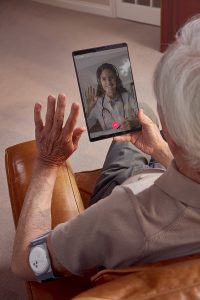The Role of Telemedicine in Hospital at Home
By Adam Wolfberg, M.D., MPH
In the eighteen months since CMS issued the acute hospital care at home waiver, the US healthcare industry has made progress in decentralizing and innovating care. With more than 200 hospitals in 34 states approved for the waiver, health systems continue to look to the Hospital at Home model to increase hospital capacity, improve quality for patients, and enable cutting-edge patient experiences.
And for good reasons. The care model offers impressive outcomes. Compared to facility-based care, Hospital at Home programs can drive a 70% reduction in 30-day readmissions, a 38% reduced cost of care, and lead to a 35% decrease in length of stay. These programs have consistently demonstrated that patients are safer, happier, and that they heal faster when acute services can be delivered within their home.
What the CMS Acute Hospital Care at Home Waiver Requires for Telemedicine
Because of the emergency nature of the current CMS waiver, the waiver itself requires relatively little in terms of telemedicine. However, most programs have found it to be an indispensable tool for creating top-notch patient experiences and operationalizing the program as a whole.
The waiver requires the following criteria be met for on-demand patient support:
- The patient must have immediate telephonic access to a clinical team member
- This team member must be able to immediately connect them with an RN or MD
- CMS requires detailed information about how a patient can immediately contact a hospital team member including what technology will be used, who will be staffing the service for the hospital, and if there are evening or weekend coverage limitations.
How Telemedicine Defines Hospital at Home Experiences for Patients and Providers

Under the waiver requirement of two in-home visits a day, current Hospital at Home programs are all hybrid care models, relying on a combination of in-person and remote care. This means that patients will have a clinician present with them for, at the most, two hours each day. Since the in-home visit is typically conducted by a nurse or MIH paramedic, who places a call to the supervising physician while onsite, telemedicine ensures all relevant members of the care team can see the patient and conduct a visual examination.
Putting Eyes on the Patient
While an audio call may be enough for acutely ill patients to relay information about symptoms, an interaction that includes video provides significantly more data about the patient’s overall wellbeing—as any experienced virtualist provider well knows. It’s important for providers to put eyes on the patient in order to manage clinical risk and respond confidently to a patient’s changing condition.
The privacy inherent in these interactions allows patients to share more vulnerable or uncomfortable aspects of their health or living conditions, enabling Hospital at Home programs to become a tool for addressing health inequities and SDoH factors for at-risk patients.
Further, one of the main challenges of building and scaling a Hospital at Home program is growing patient enrollment with the participation of referring physicians. Offering 24/7 on-demand telemedicine that includes audio and video connection helps to build confidence with all parties. In many cases, patients refer to this connection with their providers as their “lifeline.”
The Technology and Operations Supporting Acute Care at Home
At its most basic level, the acute hospital care at home waiver requires providers to deliver all services the patient needs within their place of residence. To get to this point, providers need ongoing insight into how each patient is doing. Hospital at Home is spurring providers to combine telemedicine with other tools to create a complete picture of the patient, remotely.
It is imperative for Hospital at Home programs to bring together:
- Remote patient monitoring tailored to the patient’s diagnosis
- A clinical dashboard that tracks vitals over time and triggers alarms when a patient is deteriorating
- Audio and video calling, accessible through an app on the patient’s phone or a tablet provided by the program
- Configurable reminders for medication adherence and therapies, along with asynchronous messaging
- A tool for delivering connectivity for the monitoring and communication, in the event the patient does not have access to in-home broadband internet
- EHR integrations
Hospital at Home programs represent a real shift for telemedicine. In concert with other digital health tools, it can now extend its reach into higher acuity clinical encounters. By combining the intimacy of in-home care with the breadth of services available in a hospital, telemedicine and its practitioners will have an even deeper impact on patient care in the years to come.
 About the Author
About the Author
Adam oversees clinical innovation, research initiatives and customer adoption of Current Health’s care-at-home platform. Prior to Current Health, he served as Chief Medical Officer of Ovia Health and Director of Clinical Effectiveness at athenahealth. Adam is also a trained obstetrician and continues to practice at the Cambridge Health Alliance in Massachusetts. Visit Current Health / Best Buy Health at ATA2022, Booth #1208!

